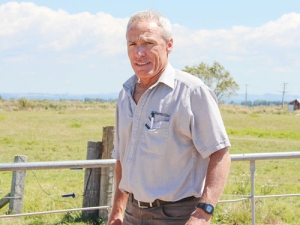A Northland farm consultant is concerned at the loss in cow condition over the last two months.
He worries about the harm this could have on milk production and in-calf rates for next season.
Tight cashflows from the lower payout are making farmers more cautious about buying more supplements to help bridge the gap in feed.
With spring a long way off, Neil Smith, a FarmWise consultant, is encouraging farmers to take action now to get their cows back on track.
"I know December was particularly difficult in Northland, with very dry conditions reducing pasture supply and farmers using less supplementary feed. Recent rainfall will have improved the feed situation for some, and relieved the immediate pressure on cow condition, but it still needs to be monitored closely over the coming months to minimise negative impact on next season's production and mating performance," he said.
DairyNZ targets state a mature cow should be at body condition score (BCS) 5.0 at calving. Heifers and rising three-year-olds should be BCS 5.5.
"I've seen cows that are half a BCS lower than this time last year, with the average dropping below 4.0 and an increasing number of cows at BCS 3.5 or less," Smith says.
"That's too low, particularly 3.5 and below. Those cows now need to be monitored closely. These are the more at-risk cows and will require the greatest gain in condition before calving."
To help farmers take action, and cow get their cows back on track, Smith offers the following tips and strategies:
Condition score the cows – now. This will tell you the average condition of the herd, the range and percentage of the herd at various BCS. Do this thoroughly. The more cows scored, the more accurate the result. If you are not good at condition scoring get someone in who is. Score at least 70-80 cows from each milking herd. This can now be recorded on a mobile phone and downloaded to Minda. Select at least 15 cows (depending on herd size) to monitor leading up to calving and review how condition is changing through to calving, especially for the priority young cows. Make sure these cows range in age, BCS and calving date.
Assess the likely farm conditions through to calving.
What will be the likely pasture supply and quality through to calving? What are the resources available in supplements, crops, grazing off and staff? Some supplement made need to be kept till after calving.
Develop a longer term plan and set strategies through to calving. Make sure this is done in conjunction with a financial budget. Include the number of cows and young stock to be grazed, allocation of supplement and crops, the amount of grazing off available, milking frequency and drying off protocol.
Allocate enough time for cows to put on condition. This can be a major reason why cows don't reach target condition at calving. Take into account the dry-off period and the last month of pregnancy where there is no gain in condition.
The type of feed used in the dry-off period can have a major impact on gaining body condition. Most winter grazing off for cows in Northland is on poor quality pasture such as matted kikuyu. Be realistic about putting on cow condition in these situations. Take this into consideration when drying off cows.
Continue to monitor cow condition through to calving on a regular basis. Cows should be condition scored every two months from mid-lactation (February-March), at a minimum.
For herds calving in June and early July, regular condition scoring should start in February. Early calving heifers at BCS 3.5 or less will need to be dried off in February if only being fed on pasture in the dry period.
Make sure both the milking and dried off cows are scored. Often heifers are dried off early in the summer months based on low body condition, but then not fed well enough to achieve target condition for calving.
At each condition scoring, record daily feed intake and key performance indicators such as milk production, available supplements and pasture cover. This information is helpful in deciding the immediate management options. These options could be OAD milking heifers, increasing supplement levels or drying off low conditioned cows.
Rainfall is difficult to predict, but no rain for long periods can have a big impact on pasture supply.
In difficult conditions, when cow condition can change quickly, condition score weekly.
Keep reviewing and revising the plan, and be prepared to make changes as required.


















